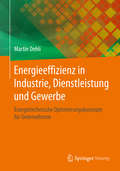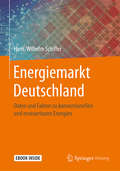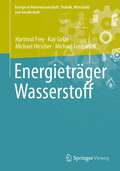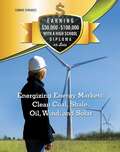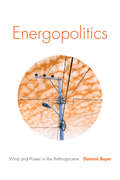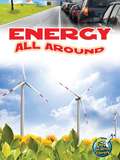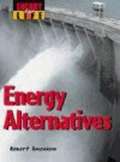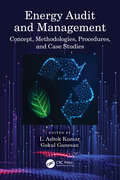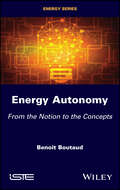- Table View
- List View
Energieeffiziente Wärmeversorgung von Gebäuden: Tatsächliche Versorgungsverhältnisse und Maßnahmen zur Effizienzsteigerung
by Wolfgang HeßeDieses Buch beschreibt die anlagentechnischen Komponenten für die Wärmeversorgung von Gebäuden sowie die Anlagentechnik und die dazugehörigen Parameter. Es wird beschrieben, wie die Parameter für eine energieeffiziente Auslegung zu wählen sind. Auf diese Weise hilft das Buch dem Praktiker bei einer kundenorientierten und energieoptimierten Umsetzung.
Energieeffiziente elektrische Antriebe
by Johannes TeigelkötterDer effiziente Einsatz elektrischer Energie in der elektrischen Antriebstechnik ist notwendig, da hier ca. 2/3 der erzeugten elektrischen Energie verbraucht werden. In diesem Lehrbuch werden die notwendigen technischen Grundlagen und Methoden zur Effizienzsteigerung in der elektrischen Antriebstechnik behandelt. Insbesondere wird durch eine gründliche Einführung in die Raumzeiger-Rechnung ein detailliertes Verständnis von modernen Antrieben mit Asynchron- und Synchronmotoren ermöglicht. Neben den elektrischen Maschinen werden die Steuerverfahren für Pulswechselrichter, Regelverfahren und Sensoren für energieeffiziente Antriebe beschrieben. Jedes Kapitel schließt mit Übungsaufgaben, um die Lehrinhalte zu vertiefen.
Energieeffizienz in Industrie, Dienstleistung und Gewerbe: Energietechnische Optimierungskonzepte für Unternehmen
by Martin DehliEin wesentlicher Anteil der in Deutschland benötigten Endenergien entfällt auf die Sektoren Industrie, Gewerbe, Handel und Dienstleistungen. Wegen der Vielfalt der dort eingesetzten Maschinen- und Anlagentechniken sowie Fertigungsverfahren stellen sich besondere Anforderungen an Fachleute, die mit den Aufgaben des Energieeinsatzes in Betrieben betraut sind. Das vorliegende Buch benennt zahlreiche Möglichkeiten der Energieeinsparung unter technischen Gesichtspunkten.
Energieeffizienz in der Industrie
by Markus Blesl Alois KesslerDas vorliegende Buch quantifiziert die Potenziale für mehr Energieeffizienz in der Industrie anhand technologie- und branchenbezogener Analysen. Ausgehend von den methodischen Grundlagen werden im ersten Teil die strom- und wärmebasierten Querschnittstechnologien und -prozesse anhand zahlreicher Anwendungsbeispiele erörtert. Neben so klassischen Themen wie bspw. Beleuchtung oder Wärmerückgewinnung werden auch bisher weniger beachtete Prozesse wie die Trocknung oder die Lackierung erfasst. Der zweite Teil ist der energieintensiven Metallerzeugung und -verarbeitung, der Herstellung der nichtmetallischen Werkstoffe Zement und Glas sowie der Chemie-, Papier- und Lebensmittelindustrie gewidmet. Beide Teile werden abschließend in einen größeren energie- und volkswirtschaftlichen Kontext gestellt. Die Erkenntnisse werden an vielen Stellen zu Checklisten verdichtet und in der Gesamtschau am Ende zu allgemeingültigen Empfehlungen zusammengefasst.
Energiemanagement nach ISO 50001: Energieeffizientes Management (essentials)
by Manfred SietzEnergieeffizientes Handeln eines Unternehmens wird weltweit einheitlich und zertifizierbar durch die Norm ISO 50001 beschrieben. Sie schafft einen einheitlichen Rahmen, um die Energieeffizienzleistung von Unternehmen zu verbessern und vergleichbar zu machen.
Energiemarkt Deutschland: Daten und Fakten zu konventionellen und erneuerbaren Energien
by Hans-Wilhelm SchifferEnergiewirtschaftliche Entscheidungen und technische Weichenstellungen erfordern eine fundierte Datenbasis. Die wichtigsten Zahlen und Fakten zu deutschen und europäischen Energiemärkten (Mineralöl, Braunkohle, Steinkohle, Erdgas und Elektrizität), zu den Eigentumsverhältnisse von über 100 Energieunternehmen und Nachfrage- sowie Angebotsstrukturen sind in diesem Buch vermittelt. Es bietet sich als Nachschlagewerk und Einführung in die vielfältige Thematik an. Über 100 Tabellen und mehr als 200 Diagramme erleichtern den Zugang zu den umfangreichen Daten. Ein Glossar hilft dabei, Klarheit in die unterschiedlichen Begrifflichkeiten zu bekommen. Berater, Entscheider und an Kennzahlen interessierte Leser finden in diesem Buch umfangreiches Material für die eigene fachliche Fragestellung. Der Autor ist Executive Chair of the World Energy Resources Programme des World Energy Council, London. Er war viele Jahre in zwei Bundesministerien sowie in leitender Funktion bei einem großen Energieunternehmen tätig und ist Lehrbeauftragter in verschiedenen Masterstudiengängen an der RWTH Aachen.Aus dem Inhalt- Grundlagen der Energiewirtschaft- Struktur einzelner Energie-Teilmärkte- Erneuerbare Energien- Preisbildung in der Energiewirtschaft- Entwicklung der Energienachfrage- Klimaschutz und Emissionshandel- Perspektiven der Energieversorgung- Energiepolitik (Bundesebene)
Energiestädte
by Dieter D. Genske Dagmar Everding Ariane RuffMit der Loslösung der Städte und Regionen von fossil-nuklearen Energiequellen gewinnt der energetisch-ökologische Stadtumbau zunehmend an Bedeutung. Eine wachsende Zahl von Akteuren engagiert sich für die Umstellung der Energieversorgung auf erneuerbare Energien sowie für ressourcenschonende ökologische Kreisläufe in ihrem Lebensumfeld. Der energetisch-ökologische Stadtumbau verbessert die Lebens- und Umweltverhältnisse in den Stadtteilen unmittelbar, eröffnet neue Chancen der Wertschöpfung und schafft Arbeitsplätze. Städte werden zu Energiestädten umgebaut, die den Leitmotiven der Nachhaltigkeit, der Minimierung energetisch-ökologischer Fußabdrücke und der Reduzierung des Flächenverbrauchs folgen.Das Buch entwirft Zukunftsbilder des Stadtumbaus für den Diskurs der Akteure. Es werden stadtplanerische, ingenieurtechnische und ökonomische Handlungsfelder des energetisch-ökologischen Stadtumbaus einschließlich ihrer methodischen Lösungswege disziplin-übergreifend beschrieben. Zu dieser Darstellung gehört auch die Verdeutlichung anhand einer Vielzahl interessanter Projektbeispiele.Zielgruppe dieses Buches sind insbesondere Kommunalverwaltungen und Klimaschutzmanager, Planungs- und Ingenieurbüros, Umweltorganisationen sowie Studierende und Lehrende.
Energieträger Wasserstoff (Energie in Naturwissenschaft, Technik, Wirtschaft und Gesellschaft)
by Hartmut Frey Michael Hirscher Kay Golze Michael FelderhoffIn diesem Buch sind die Besonderheiten von Wasserstoff als zukünftigen Energieträger im Rahmen der nationalen Wasserstoffstrategie Deutschland von ausgewiesenen Kennern in einer bisher ungekannte Bandbreite beleuchtet. Herstellung, die Bedeutung von Speichersystemen im Energiesystem sowie tiefgehende Details bei der Materialbetrachtung von verschiedenen Oberflächenproblemen sind ergänzt durch eine kurze Übersicht über den möglichen konkreten Einsatz von Wasserstoff. Dabei wird auf Möglichkeiten eingegangen, wie vor dem Hintergrund der globalen Klimaerwärmung der Treibhausgasausstoss praxis- und bürgernah abgesenkt werden kann.Der InhaltCharakteristika von Wasserstoff, Herstellungsverfahren, ProzesseGroßflächige nachhaltige Energieerzeugung zur Produktion des Energieträgers WasserstoffsWasserstoffspeicher und ihre AnwendungWie sicher ist die Nutzung von Wasserstoff?Speichertechnologien für WasserstoffMärkte für Wasserstoffspeicher und Bedeutung von Wasserstoff im Energiesystem und Technische Systeme für die NutzungWasserstoffnutzung in Gebäuden und kleinen SiedlungenDie ZielgruppenFachleute aus Industrie, Unternehmen und Politik, Architekten, Ingenieure, Studierende und Dozenten.Die AutorenProf. Dr. Hartmut Frey hat an der Universität Stuttgart Maschinenbau und Theoretische Physik studiert und in Plasmaphysik promoviert. Prof. Frey war Entwicklungsleiter der Leybold-Heraeus GmbH in Hanau und Köln. Er war Gastprofessor am Institut für Luftverkehr der Technischen Universität in Sofia (Bulgarien) und ist korrespondierender Professor an den Universitäten in Tomsk und Sofia.Kay Golze engagierte sich den 2010er für die Entwicklung der Elektromobilität. Im folgenden Jahrzehnt entwickelte er verschiedene Lösungen zur Anwendung von Wasserstoff im industriellem Maßstab. Als Mitglied des Wissenschaftsnetzwerk stellt er seine Analysen einer breiten Wissenschaftsgemeinde zur Verfügung, sowie anderen Wissenschaftlern und Unternehmen.Dr. Michael Hirscher ist seit 1987 wissenschaftl. Mitarbeiter am MPI für Metallforschung (jetzt Intelligente Systeme) und seit1991 Gruppenleiter "Wasserstoffspeicherung" am MPI-MF/MPI-ISDr. Michael Felderhoff ist wissenschaftlicher Mitarbeiter am Max-Planck-Institut für Kohlenforschung in Mülheim an der Ruhr. Seit 1999 befasst er sich mit der Synthese und Charakterisierung von Metallhydriden zur Speicherung von Wasserstoff und Wärme und der Umsetzung der Ergebnisse in Demonstrationsprojekte.
Energiewende “Made in Germany”: Low Carbon Electricity Sector Reform In The European Context
by Christian Von Hirschhausen Clemens Gerbaulet Claudia Kemfert Casimir Lorenz Pao-Yu OeiThis book provides an in-depth analysis of the energy transformation process ongoing in Germany, now commonly referred to as energiewende, in the European context, with a focus on the electricity sector. It presents an expert look at the origins of the German energiewende, its concrete implementation, its impacts within the European context as well as medium and long-term perspectives. The authors, internationally recognized energy, electricity, and climate economists at the German Institute for Economic Research (DIW Berlin) and Berlin University of Technology, conclude that the first years of the energiewende have successfully laid the foundation for a renewables-based electricity system in Germany, but that challenges remain in relation to decarbonizing the electricity system and phasing out nuclear energy. The authors also provide ground-breaking insights to inform energy policy in other countries and at the European level. In the outlook, the authors explore upcoming issues, such as coupling between the electricity and other sectors, and behavioral changes of industry and households. The book addresses readers in the energy industry, energy and climate policymakers, regulators, and others interested in the low carbon energy system transformation in Germany, Europe, and worldwide.
Energiewirtschaft 2014: Fakten und Chancen der Tiefen Geothermie (essentials)
by Willi Freeden Mathias Bauer Hans Jacobi Thomas NeuDie durch das Reaktorunglück in Fukushima forcierte Energiewende hin zu einer Stromversorgung mit primär erneuerbaren Energien konzentriert sich in der aktuellen Wahrnehmung nur auf den Ausbau von Solar und Windkraftenergie. Dabei wird vergessen, dass aufgrund fehlender Stromspeichertechnologien und Überlandstromtrassen eine erneuerbare Energie benötigt wird, die konstant Strom liefern und so Erzeugungsschwankungen bei Solar- und Windkraftenergie ausgleichen kann. Tiefe Geothermie, also Energie, die aus der Erde kommt, kann diese Aufgabe leisten, da sie die einzige erneuerbare Energie ist, die nicht klimatischen oder wetterbedingten Schwankungen unterliegt. Mit einem durch Wissenschaftlern und Praktikern erstellten Normenkatalog für tiefengeothermische Bohrungen, würde hier ein höchstmöglichen Sicherheitsstandard erreicht, und die wirtschaftlichen wie geologischen Risiken jedes Projektes minimiert werden.
Energizing Energy Markets: Clean Coal, Shale, Oil, Wind, and Solar (Earning $50,000 - $100,000 with a High S #14)
by Connor SyrewiczFor many high school graduates, college is a way to get ahead, but going to college is not the only way for young adults to succeed. Many people choose to enter the workforce after high school to start earning money and gaining experience right away. These motivated young workers can have rewarding jobs without ever having to earn a 4-year college degree. If you're interested in green energy and don't know that you want to--or can--go to college, a career in new energy markets might be for you. Young people need only a high school diploma or equivalent to start work in many new energy fields, and they can eventually earn more than $50,000 a year. In Energizing Energy Markets: Clean Coal, Shale, Oil, Wind, Solar, you'll learn how to start a career in energy and what you need to succeed in the changing industry. Find out about the prospects for energy careers in the future, how much energy workers can make each year, and whether your path to success includes a career in new energy markets like wind, solar, and natural gas.
Energizing Neoliberalism: The 1970s Energy Crisis And The Making Of Modern America (Energy Humanities Ser.)
by Caleb WellumEnergopolitics: Wind and Power in the Anthropocene
by Dominic BoyerBetween 2009 and 2013 Cymene Howe and Dominic Boyer conducted fieldwork in Mexico's Isthmus of Tehuantepec to examine the political, social, and ecological dimensions of moving from fossil fuels to wind power. Their work manifested itself as a new ethnographic form: the duograph—a combination of two single-authored books that draw on shared fieldsites, archives, and encounters that can be productively read together, yet can also stand alone in their analytic ambitions. In his volume, Energopolitics, Boyer examines the politics of wind power and how it is shaped by myriad factors, from the legacies of settler colonialism and indigenous resistance to state bureaucracy and corporate investment. Drawing on interviews with activists, campesinos, engineers, bureaucrats, politicians, and bankers, Boyer outlines the fundamental impact of energy and fuel on political power. Boyer also demonstrates how large conceptual frameworks cannot adequately explain the fraught and uniquely complicated conditions on the isthmus, illustrating the need to resist narratives of anthropocenic universalism and to attend to local particularities.
Energy
by Chris WoodfordDefines energy, giving examples of both potential and kinetic forms; explains how energy is released and travels; and provides detailed discussions of many energy sources.
Energy
by Matt MullinsA True Book--Physical Science Whether you're an aspiring inventor or an everyday science buff, you've probably created your own experiments to uncover the truth about the forces of physical science. <P><P>Now you can delve deeper into the topics of electricity, motion, gravity, and more with these titles that are perfect for the budding scientist in you.
Energy
by Robert SneddenSmart Science is a new science series designed to grab hold of your intermediate learners. Topics match all the key curriculum areas for this age, and include dozens of simple, fun-to-do experiments that help students apply the concepts presented on each spread.
Energy
by Yaşar DemirelUnderstanding the sustainable use of energy in various processes is an integral part of engineering and scientific studies, which rely on a sound knowledge of energy systems. Whilst many institutions now offer degrees in energy-related programs, a comprehensive textbook, which introduces and explains sustainable energy systems and can be used across engineering and scientific fields, has been lacking. Energy: Production, Conversion, Storage, Conservation, and Coupling provides the reader with a practical understanding of these five main topic areas of energy including 130 examples and over 600 practice problems. Each chapter contains a range of supporting figures, tables, thermodynamic diagrams and charts, while the Appendix supplies the reader with all the necessary data including the steam tables. This new textbook presents a clear introduction of basic vocabulary, properties, forms, sources, and balances of energy before advancing to the main topic areas of: * Energy production and conversion in important physical, chemical, and biological processes, * Conservation of energy and its impact on sustainability, * Various forms of energy storage, and * Energy coupling and bioenergetics in living systems. A solution manual for the practice problems of the textbook is offered for the instructor. Energy: Production, Conversion, Storage, Conservation, and Coupling is a comprehensive source, study guide, and course supplement for both undergraduates and graduates across a range of engineering and scientific disciplines. Resources including the solution manual for this textbook are available for instructors on sending a request to Dr. Yaºar Demirel at ydemirel@unl.edu
Energy All Around (My Science Library)
by Buffy SilvermanThis book explains how all forms of energy are either potential or kinetic. It addresses how energy can be used in the form of water to create electricity, in the solar form to heat our homes, and in the form of wind to turn the blades on a wind turbine.
Energy Alternatives
by Robert SneddenEnergy Alternatives explores sources of energy that offer an alternative to nuclear and fossil fuels. It explains the benefits of renewable energy sources, and the part they will play in the future. The book examines how each energy source affects the environment.
Energy Applications of 2D Nanomaterials
by Ram K. Gupta2D nanomaterials have emerged as promising candidates for use in energy devices owing to their superior electrochemical properties, surface area, nanodevice integration, multifunctionality, printability, and mechanical flexibility. Energy Applications of 2D Nanomaterials covers a wide range of applications of 2D nanomaterials for energy, as well as future applications and challenges in fabricating flexible energy generation and storage devices. This book: Examines 2D nanomaterials for solar cells, fuel cells, batteries, supercapacitors, and flexible devices Details novel methods and advanced technologies Covers future applications and challenges This book is aimed at materials scientists, chemists, electrochemists, and engineers working in energy disciplines.
Energy Audit and Management: Concept, Methodologies, Procedures, and Case Studies
by L. Ashok Kumar Gokul GanesanThis book describes the energy management concepts, energy audit principles, resource efficiency, and other energy conservation opportunities involved in different sectors across varied industries. Real-time case studies from various large industrial sectors, like cement, paper and pulp, refineries, manufacturing, garments and textile processing, power plants, and other MSME industrial sectors with cross functional energy conservation opportunities, are included. It also describes the future scope of energy auditing and management including IoT and data analytics. It also helps to gather the energy generated and utilization, energy conservation, and other process related data. Features: Provides entire coverage of energy management and audit concepts. Explores energy audit methodologies and energy saving initiatives. Incorporates current technologies like machine learning, IoT, data analytics in energy audit for reliability improvement. Includes case studies covering detailed energy saving calculation with investment pay back calculations. This book is aimed at researchers, professionals, and graduate students in electrical engineering, power systems, energy systems, and renewable energy.
Energy Audit of Building Systems: An Engineering Approach, Third Edition (Mechanical and Aerospace Engineering Series)
by Moncef KrartiUpdated to include recent advances, this third edition presents strategies and analysis methods for conserving energy and reducing operating costs in residential and commercial buildings. The book explores the latest approaches to measuring and improving energy consumption levels, with calculation examples and Case Studies. It covers field testing, energy simulation, and retrofit analysis of existing buildings. It examines subsystems—such as lighting, heating, and cooling—and techniques needed for accurately evaluating them. Auditors, managers, and students of energy systems will find this book to be an invaluable resource for their work. Explores state-of-the-art techniques and technologies for reducing energy combustion in buildings. Presents the latest energy efficiency strategies and established methods for energy estimation. Provides calculation examples that outline the application of the methods described. Examines the major building subsystems: lighting, heating, and air-conditioning. Addresses large-scale retrofit analysis approaches for existing building stocks. Introduces the concept of energy productivity to account for the multiple benefits of energy efficiency for buildings. Includes Case Studies to give readers a realistic look at energy audits. Moncef Krarti has vast experience in designing, testing, and assessing innovative energy efficiency and renewable energy technologies applied to buildings. He graduated from the University of Colorado with both MS and PhD in Civil Engineering. Prof. Krarti directed several projects in designing energy-efficient buildings with integrated renewable energy systems. He has published over 3000 technical journals and handbook chapters in various fields related to energy efficiency, distribution generation, and demand-side management for the built environment. Moreover, he has published several books on building energy-efficient systems. Prof. Krarti is Fellow member to the American Society for Mechanical Engineers (ASME), the largest international professional society. He is the founding editor of the ASME Journal of Sustainable Buildings & Cities Equipment and Systems. Prof. Krarti has taught several different courses related to building energy systems for over 20 years in the United States and abroad. As a professor at the University of Colorado, Prof. Krarti has been managing the research activities of an energy management center at the school with an emphasis on testing and evaluating the performance of mechanical and electrical systems for residential and commercial buildings. He has also helped the development of similar energy efficiency centers in other countries, including Brazil, Mexico, and Tunisia. In addition, Prof. Krarti has extensive experience in promoting building energy technologies and policies overseas, including the establishment of energy research centers, the development of building energy codes, and the delivery of energy training programs in several countries.
Energy Autonomy: From the Notion to the Concepts
by Benoit BoutaudEnergy autonomy is an emerging concept that is, as yet, poorly identified in France. It can mean taking ownership of certain issues related to energy, its production, or, indeed, becoming self-sufficient, and it can apply equally to individuals, communities and buildings.While there are numerous new developments – renewable energies, smart grids and self-consumption – it is becoming difficult to know what this idea of &“autonomy&” covers, just as it is difficult to define &“independence&” and &“self-sufficiency&”, which are often associated with it. However, these three concepts are key to thinking about the energy system and deciding its future. Covering distinct ideas, they are often reduced to economic and productive factors. This ambiguity in their meanings is responsible for the misunderstandings, delusions and obstacles that hamper the implementation of the energy transition.This book deconstructs the common idea of autonomy in favor of a set of more operational concepts. It demonstrates that these ideas are not interchangeable but rather represent practical and constructive tools for action. The world of energy is changing, and therefore we must rethink energy autonomy.
Energy Balance Climate Models
by Gerald R. North Kwang-Yul KimWritten by renowned experts in the field, this first book to focus exclusively on energy balance climate models provides a concise overview of the topic. It covers all major aspects, from the simplest zero-dimensional models, proceeding to horizontally and vertically resolved models. The text begins with global average models, which are explored in terms of their elementary forms yielding the global average temperature, right up to the incorporation of feedback mechanisms and some analytical properties of interest. The effect of stochastic forcing is then used to introduce natural variability in the models before turning to the concept of stability theory. Other one dimensional or zonally averaged models are subsequently presented, along with various applications, including chapters on paleoclimatology, the inception of continental glaciations, detection of signals in the climate system, and optimal estimation of large scale quantities from point scale data. Throughout the book, the authors work on two mathematical levels: qualitative physical expositions of the subject material plus optional mathematical sections that include derivations and treatments of the equations along with some proofs of stability theorems. A must-have introduction for policy makers, environmental agencies, and NGOs, as well as climatologists, molecular physicists, and meteorologists.


